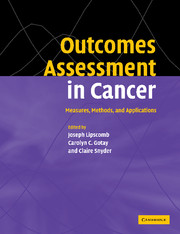Book contents
- Frontmatter
- Contents
- List of contributors
- Acknowledgments
- 1 Introduction to Outcomes Assessment in Cancer
- Health-related quality of life in cancer: general concepts and generic measures
- Assessing health-related quality of life during treatment
- Assessing health-related quality of life across the cancer continuum
- Measuring the experience and needs of cancer patients and caregivers
- Methodological considerations in applications to cancer outcomes research
- 17 Practical considerations in outcomes assessment for clinical trials
- 18 Statistical issues in the application of cancer outcome measures
- 19 The clinical value and meaning of health-related quality-of-life outcomes in oncology
- 20 Cross-cultural use of health-related quality of life assessments in clinical oncology
- Modern psychometric theory in cancer outcomes research
- Assessing the economic impact of cancer
- Research and policy implications
- Invited papers
- Index
- References
17 - Practical considerations in outcomes assessment for clinical trials
Published online by Cambridge University Press: 18 December 2009
- Frontmatter
- Contents
- List of contributors
- Acknowledgments
- 1 Introduction to Outcomes Assessment in Cancer
- Health-related quality of life in cancer: general concepts and generic measures
- Assessing health-related quality of life during treatment
- Assessing health-related quality of life across the cancer continuum
- Measuring the experience and needs of cancer patients and caregivers
- Methodological considerations in applications to cancer outcomes research
- 17 Practical considerations in outcomes assessment for clinical trials
- 18 Statistical issues in the application of cancer outcome measures
- 19 The clinical value and meaning of health-related quality-of-life outcomes in oncology
- 20 Cross-cultural use of health-related quality of life assessments in clinical oncology
- Modern psychometric theory in cancer outcomes research
- Assessing the economic impact of cancer
- Research and policy implications
- Invited papers
- Index
- References
Summary
While clinical outcomes are often the primary method of evaluation in clinical trials, endpoints requiring patient-reported measures are essential. The scientific literature is full of reports where investigators make logical but unsubstantiated claims of quality-of-life benefits to patients based on the assumption that a change in treatment or a traditional biomedical outcome will improve the patient's quality of life. While in many cases this may be true, surprising results are sometimes obtained when the patient is asked directly. One classic example occurred with a study by Sugarbaker et al. comparing two therapeutic approaches for soft-tissue sarcoma. The first was limb-sparing surgery followed by radiation therapy. The second treatment approach was full amputation of the affected limb. The investigator hypothesized that “Sparing a limb, as opposed to amputating it, offers a quality of life advantage.” Rather than assuming this was true, the investigators tested their hypothesis. Subjects who received the limb-sparing procedures reported limitations in mobility and sexual functioning. These observations were confirmed with physical assessments of mobility and endocrine function. As a result of these studies, the original hypothesis was rejected, radiation therapy was modified, and physical rehabilitation was added to the limb-sparing therapeutic approach.
There is a danger of adding patient-based outcomes to every clinical trial. If the majority of these studies either fail to answer clinically relevant questions or are methodologically weak, eventually a negative perception about patient-centered outcomes will grow in the research community.
- Type
- Chapter
- Information
- Outcomes Assessment in CancerMeasures, Methods and Applications, pp. 346 - 361Publisher: Cambridge University PressPrint publication year: 2004
References
- 1
- Cited by



